HOW TO FEED A HUMMINGBIRD PART I: INSECTS & PROTEIN
This is Part I of a two-part series.
There’s high excitement on this lovely afternoon as a male ruby-throated hummingbird guzzles at our feeder. It’s my first sighting of this wee bird this year. “Oh, have I been waiting for you!” Last spring’s first long distance traveler made his fueling pit stop in our garden around this time so I was prepared for today’s little fella.
Shimmering green with the identifying ruby throat patch flashing in the sun, he perches for a long while, taking in the homemade sugary solution. “Drink up, my friend.” If there’s a repeat of the previous years’ pattern, this particular hummer will continue his journey north to other breeding grounds and a short time later two or sometimes three other hummingbirds will frequent our garden and make this area in Northern Virginia their summer home. Zooming, flitting, hovering and thoroughly delighting, our resident hummingbirds have become very special guests in our wildlife habitat.
So, what’s the secret to supporting these extraordinary creatures during their stay here in the Mid-Atlantic? It’s not simply hanging up a sugar-filled feeder.
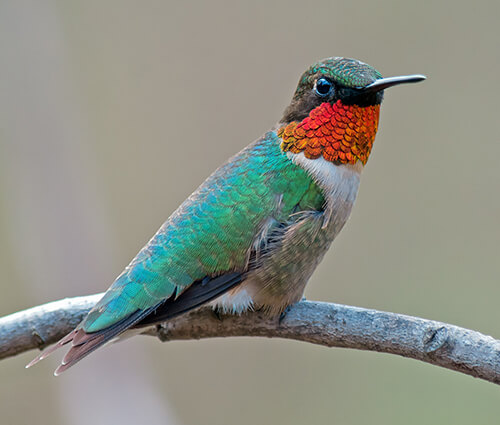
A male ruby-throated hummingbird (Archilochus colubris). Photo by Tibor Nagy/flickr/CC.
THE NATIVE PLANT PROMISE
Utilizing indigenous plants to support our birds and other wildlife is my ever-growing passion. Although not yet the norm in today’s society, the outdoor living space at our house is brimming with natives: pretty ground covers, flowering perennials and annuals, slender grasses, shrubs of all shapes and sizes, and mature native trees, as well as many newly planted saplings. We garden this way because we want to encourage as much biodiversity as we possibly can. You see, locally native plants co-evolved with specific insects and the majority of these insects are herbivore specialists that can only eat certain plants. These plants, called host plants, are essential to the insects’ egg-laying and larval stages.
Science has also shown us that plant-eating insects have the incredible role of transferring energy from plants to other animals that cannot eat plants. “In fact,” renowned entomologist Dr. Doug Tallamy writes, “a large percentage of the world’s fauna depends entirely on insects to access the energy stored in plants.” Native plants = insects = biodiversity.
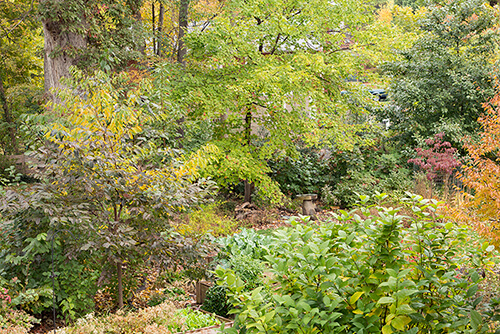
and mature shrubs directly and indirectly providing food for critters.
HUMMINGBIRD DIET REVELATION
How does this plant-insect relationship effect birds in particular? According to Tallamy, 96 percent of our terrestrial birds need insects and spiders in their diets at one stage of their lives or another. To make more birds, insects, particularly caterpillars, are not optional.
Spiders, flies, mosquitoes, aphids, bees, beetles, caterpillars and gnats, which comprise a number of flying insects, are commonly part of the ruby-throated’s protein and fat diet. In fact, some authorities, like Dr. Tallamy, view hummingbirds as insectivorous birds that happen to also eat plant nectar. “Hummingbirds like and need nectar but 80 percent of their diet is insects and spiders,” Tallamy explains. “If you don’t have those insects and spiders in your yard, it doesn’t matter how many hummingbird feeders you have, you are not going to be able to support hummingbirds.”
SPIDERS ARE AWESOME!
There’s no denying they can be big and hairy and have an inordinate number of legs, but spiders are an integral part of any healthy habitat. A gardener’s companion, spiders help consume insect pests and maintain the natural balance of the great buggy outdoors. They are equally predator and prey, providing invaluable nourishment for hummingbirds and other birds and wild animals.
Besides being a hummingbird meal, here’s another great reason to be hospitable to spiders in our gardens: hummingbirds construct their nests with the fine, sticky web material. Purdue University’s Attracting Hummingbirds to Your Yard offers these facts: “Nests are made with down from dandelion, thistle, and milkweed, and portions of ferns, mosses, and young leaves. These materials are attached to the limb with several yards of sticky spider webs and droplets of tree sap. The nest is camouflaged with lichens usually found in the nest tree or surrounding trees. Some of these nest materials can be provided in your flower beds and surrounding yard plantings.”
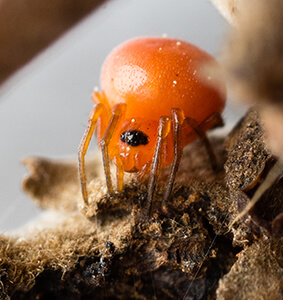
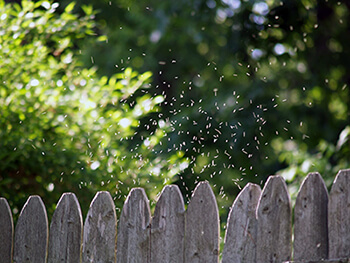
Gnats! Photo by Glenn Kraeck/flickr/CC.
LEAVE THE LEAF LITTER
The hummingbirds that frequent our garden entertain us with their aerobatic feats of mid-air gnat noshing. The clouds of fungus gnats making up this aerial buffet are drawn to the moist areas of decaying leaves that layers our property. The leaf litter is their prime egg-laying material. Although gnats are bothersome to people, probably because gnats also desire moist facial orifices, it turns out they are not an annoyance but a bonanza.
Leaf litter is also food for some butterfly larvae and this means more beneficial caterpillars. Did you know our spiders are able to survive winters under the cover of moist leaf litter? It helps them from desiccating, or drying out, which is the main cause of their mortality. Logs, branches and twigs also naturally decompose and are vital for insect nutrition and shelter. There are lots of good reasons to rejoice in the plant debris in your garden.
SOME FLOWERS ATTRACT THE TINIEST OF INSECTS
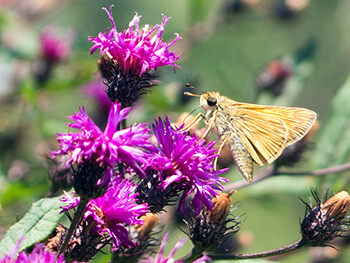
Pretty Perennial & Annual Choices
When asked about hummingbirds and attracting gnats, Alan Ford, the Potowmack Chapter President of the Virginia Native Plant Society, instantly recommended these lovely perennial genera: the pretty purple ironweeds, (Vernonia spp.), and the yellow or white goldenrods,(Solidago and Euthamia spp.). Our native asters (Symphyotrichum spp.), and coneflowers (Rudbeckia hirta and R. fulgida) are also grand perennial choices for drawing in the bugs. Dr. Tallamy has observed hummingbirds picking small insects out of the large flowerheads of the fun-to-grow annual, sunflower (Helianthus annuus), and therefore recommends planting them as well.

Shrubs with Clusters of Tiny Flowers
No garden is complete without a diversity of native shrubs. Shrubs add beauty and seasonal interest and also offer cover for birds and other animals. Additionally, they can entice the insects enjoyed by hummingbirds. Here are three that do the job well: New Jersey tea (Ceanothus americanus) is an excellent low growing deciduous shrub with tiny white flowers. Adaptable to soil moisture and found naturally growing in part sun and dappled open woods, it’s a handsome but much underused plant.
Another attractor of small insects are the pretty globe-shaped white blossoms of buttonbush (Cephalanthus occidentalis). If you have a sunny moist area for a large six to twelve foot shrub, buttonbush would be a good addition to your naturalized habitat. Summer sweet (Clethra alnifolia) is another low maintenance and adaptable shrub. It prefers moisture and can handle shady conditions. In early summer, summer sweet’s fragrant white flowers are all abuzz with pollinators of varying shapes and sizes.
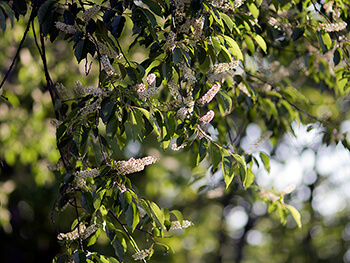
with high wildlife value.
Trees Please
LAYERING YOUR GARDEN
Advice for the native plant fledgling:
Native plants are the key components of any productive landscape. But where do you begin building native plant knowledge? Your regional native plant society chapter, of course! Through their on-line posts, field trips and lectures, these non-profit organizations provide solid information about the plants that grow naturally in your area.
Delaware Native Plant Society
Maryland Native Plant Society
The Native Plant Society of New Jersey
Pennsylvania Native Plant Society
Virginia Native Plant Society
West Virginia Native Plant Society
There are tons of native plant sales in the Mid-Atlantic at springtime and during the fall. Take advantage of the cool planting weather and of the low prices offered at native plant society events and through local environmental organizations.
For those who want an ecologically sensitive home landscape and strive to purchase native ecotype plants, find a conservation group in your region that collects and propagates wild seeds. These eco-organizations are doing outstanding work restoring and conserving natural areas and are encouraging homeowners to add locally sourced plants to their own gardens. Here in Northern Virginia we are fortunate to have Earth Sangha supporting our region.
Many thanks to Sue Dingwell for her kind assistance with this article.
Updated April 17, 2019: “Ants” were removed as an insect that hummingbirds can eat as there are no supporting studies.
